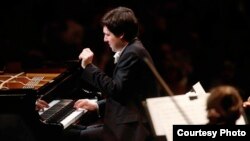Even when it comes to music, seeing is believing.
In a new study at Harvard University, people were better able to identify winners of musical competitions by watching silent video clips than by actually listening to the music. Even trained musicians fared better in picking winners just by watching the competitors.
“It’s a very counterintuitive finding — there have been some interesting reactions from musicians,” said Chia-Jung Tsay, who has PhDs in organizational behavior and music. “What this suggests is that there may be a way that visual information is prioritized over information from other modalities. In this case, it suggests that the visual trumps the audio, even in a setting where audio information should matter much more.”
It was Tsay’s own experience in music competitions that sparked her interest.
“For the last two decades, I’ve taken part in various competitions,” she said. “Through this experience, I found that depending on what type of evaluations were used — whether it was live rounds or audio recordings that had to be submitted — the results might vary widely. My intuition was that there was a much more sophisticated role for visual information.”
Tsay’s test subjects received either video clips without sound, audio clips, or video clips that included sound. After viewing the short clips, participants were asked to identify the winners.
“What I found was that people had a lower chance of identifying the eventual winner if they only listened to the sound,” Tsay said. “People who just had the video — even without the sound — had surprisingly high rates of selecting the actual winner. Even with professional musicians, who are trained to use sound, and who have both expertise and experience, it appeared that the visual information was overriding the sound.”
Tsay said that the difference in musical abilities among top performers is very slight, so from a visual standpoint the performer’s engagement, passion and energy are important factors.
“Those aspects are more closely tied to performance, or what we think of as performance, that allow the judges to distinguish between two performances,” Tsay said. “I wouldn’t expect musical novices to be able to use auditory information the same way a trained musician with 20 years of experience would, but when I ran the studies with professional musicians — people who perform as part of orchestras, or who teach at music conservatories — and I saw the same result, that was when I realized that regardless of the amount of experience, people still seem to rely on visual information.”
In a new study at Harvard University, people were better able to identify winners of musical competitions by watching silent video clips than by actually listening to the music. Even trained musicians fared better in picking winners just by watching the competitors.
“It’s a very counterintuitive finding — there have been some interesting reactions from musicians,” said Chia-Jung Tsay, who has PhDs in organizational behavior and music. “What this suggests is that there may be a way that visual information is prioritized over information from other modalities. In this case, it suggests that the visual trumps the audio, even in a setting where audio information should matter much more.”
It was Tsay’s own experience in music competitions that sparked her interest.
“For the last two decades, I’ve taken part in various competitions,” she said. “Through this experience, I found that depending on what type of evaluations were used — whether it was live rounds or audio recordings that had to be submitted — the results might vary widely. My intuition was that there was a much more sophisticated role for visual information.”
Tsay’s test subjects received either video clips without sound, audio clips, or video clips that included sound. After viewing the short clips, participants were asked to identify the winners.
“What I found was that people had a lower chance of identifying the eventual winner if they only listened to the sound,” Tsay said. “People who just had the video — even without the sound — had surprisingly high rates of selecting the actual winner. Even with professional musicians, who are trained to use sound, and who have both expertise and experience, it appeared that the visual information was overriding the sound.”
Tsay said that the difference in musical abilities among top performers is very slight, so from a visual standpoint the performer’s engagement, passion and energy are important factors.
“Those aspects are more closely tied to performance, or what we think of as performance, that allow the judges to distinguish between two performances,” Tsay said. “I wouldn’t expect musical novices to be able to use auditory information the same way a trained musician with 20 years of experience would, but when I ran the studies with professional musicians — people who perform as part of orchestras, or who teach at music conservatories — and I saw the same result, that was when I realized that regardless of the amount of experience, people still seem to rely on visual information.”







